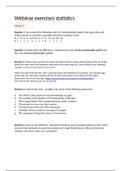Webinar exercises statistics
Week 2
Exercise 1. You entered the following code in R: table(dat$english_grade), that gives the result
below. Explain as precisely as possible what these numbers mean.
# 5 5.5 6 6.1 6.3 6.4 6.5 7 7.1 7.3 7.4 7.6 7.8
# 2 1 3 3 1 1 2 1 8 1 1 1 2
Exercise 2. Explain what the difference is between the code round(mean(dat$english_grade)) and
the code mean(round(dat$english_grade))?
Exercise 3. Marloes does not want to answer the phone and she always lets the phone ring. She writes
down how many times the telephone rings before the caller hangs up. That resulted in the following
numbers: 1,3,4,6,4,1,3,6,5,4,3,5,7,3,2,5,4,3,6.
Make a box plot with this data. Hint: a box plot shows the distribution in quartiles: four equally large
groups (Q1, Q2, Q3 & Q4), starting with the smallest observation and ending with the largest
observation. (See for an example: https://www.youtube.com/watch?v=mhaGAaL6Abw)
Give each of the values for Q1, Q2, Q3 and Q4.
Exercise 4. Indicate the units, variables and values of the following statements.
a. The African Zulu people do not acknowledge sea gods.
b. The majority of the gypsies in the Netherlands is illiterate.
c. Most organizations have a department for public relations.
d. This group has more men than women.
e. This group has more men than that group.
f. Scientific articles consist on average of 16 pages.
g. This newspaper brings the news in a formal way.
Exercise 5. Given is the statement “Apartment residents have less appreciation for their home
and are more bothered by noise than residents of single-family homes. What are the three
variables and which values are mentioned?
,Exercise 6. What is the measurement level of the following variables?
(nominal, ordinal, interval or ratio)
Variable: Values: Measurement level:
a Amount of sports practice A lot, little, nothing
.
b Political party preference PvdA, CDA, VVD, other
.
c. Response time 0, 1, 2, 3, .... milliseconds
d Attitude towards Europe positive, neutral, negative
.
e Age 1, 2, 3, ... 25 years
.
f. Age 0-10 years, 11-20 years, 21-30
years, ...
g. Year of birth 1920, 1921, 1922, ...
h Number of inhabitants per 0-100, 101-200, 201-300, ...
. km2
i. Gender male, female, non-binary
j. Type of car truck, bus, passenger car
Exercise 7. What is the mode of the data in the table below? And what is the median?
Education type Absolute frequency
Elementary 85
High school 102
Higher 77
vocational
University 102
Total 366
, Exercise 8. The essential characteristic of the ordinal measurement level is
a) Distinguishability of the scale points
b) ranking of the scale points
a) fixed unit of measurement
Week 3
Exercise 1. Which of the following statements is correct?
Statement I: Values have a certain variable.
Statement II: A sample is a subset from the population.
a) Statement I is correct and statement II is incorrect.
b) Statement I and II are both correct.
c) Statement I is incorrect and statement II is correct.
a) Statement I and II are both incorrect.
Exercise 2. For the following studies, what are the populations and samples?
a. A researcher wants to know to what extent students weekly spend enough time on their
studies. First, he selects 10 higher education institutions and then he chooses from each of
those 10 institutions 100 students. All this according to the rules of sampling. To the 1000
students, the researcher asks questions about their study activities.
b. A researcher wants to gain more insight into the population growth in The Netherlands.
From all Dutch municipalities (‘gemeentes’), the researcher draws a sample of 30
municipalities. He intends to follow the growth rates of these municipalities for the next 10
years and relate that rates to other data from these specific municipalities.
Exercise 3. Which variables are mentioned in the statement: “Elderly people do less sport than
younger people”? And for each of those variables: which values are mentioned?
Exercise 4. The notation N(mu,sd) is used to display a normal distribution with mean mu and standard
deviation sd. For example, in case of an IQ test that is N(100,16) and for the length of Dutch men it is
N(181,6).
Given N(100,16), transform the following results of found means to z-scores:
a. 92





